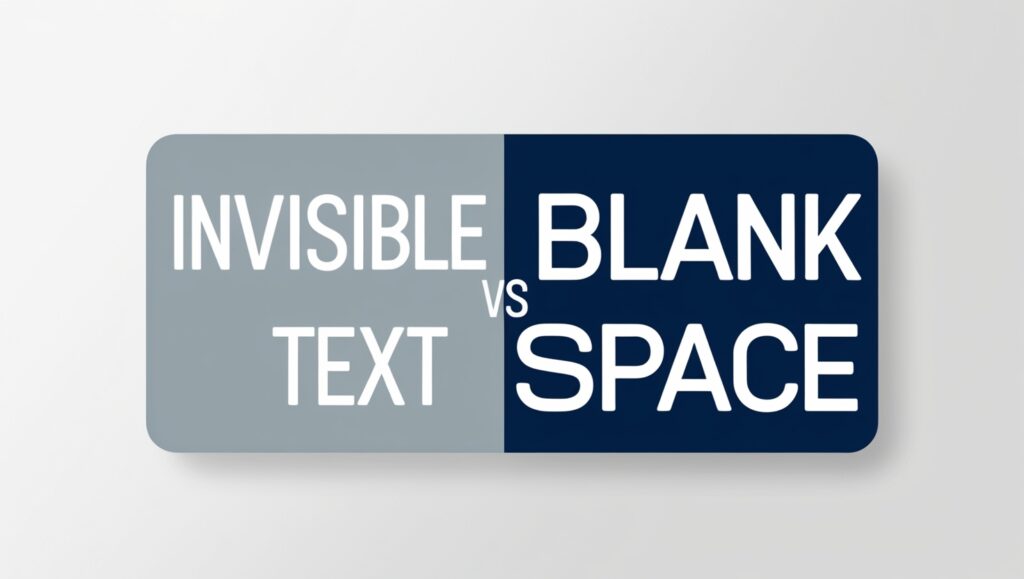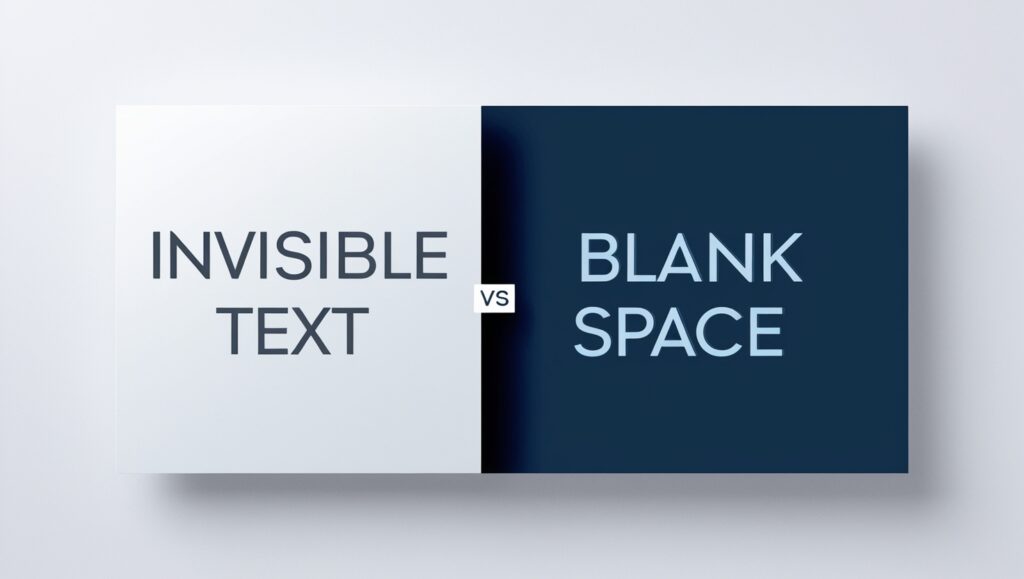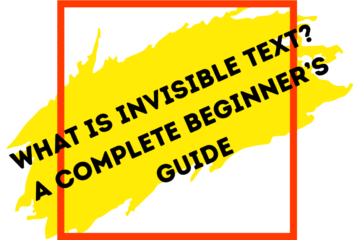Introduction
In the digital world, characters we can’t see can have a big impact. Two such characters are invisible text and blank space. While they might seem similar, they serve different purposes and can affect how text is displayed and processed. Understanding these differences is important for anyone working with digital content.Texto Invisible+2invisible-text.net+2Online Office Applications for business+2Texto Invisible
What Is Invisible Text?
Invisible text refers to characters that are present in the text but are not visible to the human eye. These characters, often zero-width spaces, don’t take up any space on the screen but can influence how text behaves. They’re commonly used in digital communication, coding, and creative content creation.Texto Invisible
What Is Blank Space?
Blank space, on the other hand, is a visible space character, like the one you create by pressing the spacebar. It’s used to separate words and sentences, making text readable. In digital terms, it’s represented by specific Unicode characters that occupy space on the screen.ptiglobal.comTexto Invisible
Key Differences Between Invisible Text and Blank Space
Here’s a comparison of invisible text and blank space:
| Feature | Invisible Text (Zero-Width) | Blank Space (Visible) |
| Visibility | Not visible | Visible |
| Width | Zero width | Occupies space |
| Common Uses | Formatting, hidden messages | Word separation |
| Unicode Examples | U+200B (Zero Width Space) | U+0020 (Space) |
| Impact on Layout | Minimal | Affects layout |
Uses of Invisible Text

Invisible text has various applications:Texto Invisible+2Texto Invisible+2Our Code World+2
- Formatting: Used to control text layout without visible changes.
- Hidden Messages: Employed in digital steganography to hide information within text.
- Preventing Linkification: Inserting zero-width spaces in URLs to prevent automatic hyperlinking.WikipediaNamecheap+1Stack Overflow+1
For more on invisible text uses, visit TextInvisible.com.Texto Invisible+1Texto Invisible+1
Uses of Blank Space
Blank spaces are essential for:
- Readability: Separating words and sentences for clarity.
- Design: Creating visual separation in layouts.
- Programming: Used in code for indentation and structure.Texto Invisible
Understanding different space characters can be found at Unicode Explorer.unicode-explorer.com+1unicode-explorer.com+1
Ethical Considerations
While invisible text can be used creatively, it can also be misused:
- Phishing: Hiding malicious links within text.
- Spoofing: Creating deceptive usernames or messages.charactertext.com+17blanktext.net+17Editpad+17Empty Character+7Texto Invisible+7Texto Invisible+7
It’s important to use these characters responsibly to maintain trust and security in digital communications.
Practical Applications of Invisible Text vs. Blank Space

Invisible Text in SEO
Invisible text can be used in various ways to manipulate search engine results. However, when used improperly, it could lead to penalties from search engines like Google. Here’s how invisible text is typically used in SEO:
- Keyword Stuffing: Some webmasters used to hide keywords in invisible text to trick search engines into ranking their pages higher. This practice is now considered black-hat SEO and can result in search engine penalties.
- Search Engine Spam: This involves hiding irrelevant text that search engines might pick up but is invisible to human visitors. Google’s algorithms have become very good at detecting this, and websites caught using invisible text for manipulation can suffer algorithmic penalties.
For more on SEO best practices, visit Google’s SEO Guidelines.
Invisible Text in Design and Development
In design and development, invisible text can be a powerful tool when used properly. Some common uses include:
- Hidden Elements: Developers sometimes use invisible text to store information that can be accessed by scripts or for testing purposes. For instance, zero-width spaces can be used to separate specific values without cluttering the visible interface.
- Accessibility Features: Invisible text can also enhance accessibility. For instance, screen readers can detect invisible characters to help visually impaired users navigate complex content. ARIA (Accessible Rich Internet Applications) guidelines recommend the careful use of invisible text to improve the user experience for those with disabilities.
To learn more about accessibility standards, you can check out the W3C Accessibility Guidelines.
Managing Invisible Text in Usernames and Social Media
Invisible text is commonly used in gaming, social media, and forums to create unique usernames or hide content from the public eye. Players often use invisible characters to circumvent username filters or create more “mysterious” profiles.
For example, platforms like Roblox or Fortnite have seen players using invisible characters to create usernames that are not easy to detect, making their profiles stand out. This is especially popular among users trying to avoid automatic bans or restrictions for using “bad” words.
However, many online platforms are now taking a harder stance on the use of invisible text in usernames. Social media platforms like Instagram or Twitter may flag these profiles as suspicious or even block them entirely.
For more about how social platforms handle usernames and gaming profiles, you can explore Roblox’s Community Guidelines.
Testing and Detecting Invisible Text
For developers and content managers, it’s crucial to know how to detect and handle invisible text. One way to test whether invisible text is present is by using online tools like:
- Invisible Text Checker: Websites like Invisible Text Checker can help you spot and remove invisible characters from your text before publishing it online.
- Regular Expressions: If you’re coding or managing a website, regular expressions (regex) can be used to find zero-width spaces and other invisible characters in your site’s content. Tools like Regex101 allow you to test patterns that match invisible Unicode characters.
Ethical and Security Concerns with Invisible Text
Despite its practical uses, invisible text can raise serious security concerns. When used improperly, it can facilitate:
- Phishing: Malicious actors can hide links within invisible text that appear normal but lead to harmful sites. The use of invisible characters can make phishing attempts harder to detect, potentially compromising users’ sensitive data.
- Spam: Spammers use invisible characters to bypass spam filters. These characters allow them to disguise unwanted messages or malicious links in ways that aren’t immediately obvious to human reviewers.
To stay secure and avoid potential misuse, it’s important to adopt security practices that help protect against such invisible character abuses. Web security services like Cloudflare and Sucuri offer excellent defenses against text-based exploits.
For more on securing your website from invisible text-related threats, visit Cloudflare Security Tips.
Conclusion
Understanding the difference between invisible text and blank space is essential for anyone involved in web development, design, and SEO. While both types of characters may seem similar at first glance, their purposes and implications are vastly different.
By using invisible text ethically and securely, you can enhance accessibility, improve content presentation, and even prank your friends—but misusing it can open the door to security vulnerabilities and ethical issues. Always be mindful of your usage to maintain the integrity and safety of your digital environments.



